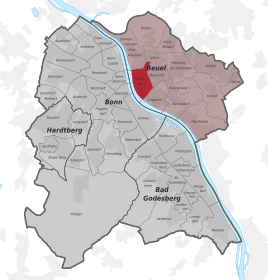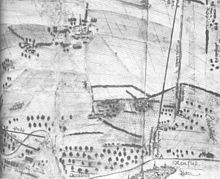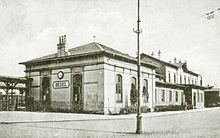Beuel center
|
Beuel center
Federal city of Bonn
Coordinates: 50 ° 44 ′ 3 ″ N , 7 ° 7 ′ 18 ″ E
|
|
|---|---|
| Height : | 54 m above sea level NHN |
| Residents : | 12,538 (Dec. 31, 2018) |
| Incorporation : | 1st August 1969 |
| Area code : | 0228 |
|
Location of the district of Beuel-Mitte in the Beuel district
|
|
Beuel-Mitte is a part of the Beuel district of Bonn . It lies between the Rhine in the west, the railway line in the east, the Bröltalbahnweg in the north and the Rosenweg in the south. Developed from earlier village settlements, Beuel-Mitte developed through its central bridge location to the core town. Because of its central location between Bonn's city center and the higher-priced Rhein-Sieg district , predominantly historical buildings and numerous new buildings in the upper price segment, along with diverse leisure, shopping and cultural infrastructure, the district is considered an "upscale" residential area.
Settlement and building history
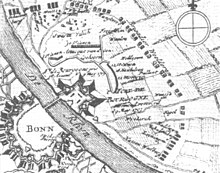
Since it was shaped by the Rhine, settlement was limited to flood-free zones. The first settlements were Rheindorf , Vilich , Beuel and Limperich and were built between the 5th and 7th centuries. At the end of the 16th century, during the Truchsessian War , a fortification was built in Beuel. During this time, Beuel was often the starting point for conquering Bonn from the Beueler Schanze . After the Treaty of Utrecht in 1713, these fortifications were dismantled. The Mehlem'sche Haus was built on the former site of the Beueler Schanze. In the 19th century, the individual settlements slowly grew together. An industrial area was developed east of the railway line. Continuous development was built between Friedrich-Breuer-Strasse and Hans-Böckler-Strasse . There was also a lot of construction going on in the area from St. Josef Church to Johannesstrasse. The number of residents tripled during this period. In 1892 the local council decided to merge the towns of Combahn and Beuel.
Mehlem's house
Presumably after the first building was destroyed in a severe flood in 1784 , a large stately villa was built in 1875, which still exists today. Since the surrounding buildings were lower, this representative, late baroque villa of the Mehlem family dominated the Rhine panorama of Beuel for over 100 years. The villa was built for either Johannes Paul Mehlem or one of his children. He held the office of bridge master. His job was to manage the operation of the ferry or Gierponte .
Due to its two gate entrances, the Mehlem'sche Haus can be compared with the Fürstenberg'schen Palais on Münsterplatz (main post office). A rear park was an integral part of this palace. In 1885 the villa was divided into five apartments and equipped with a two-storey loggia . August Wilhelm Andernach , who built the tar production plant in today's Maarstrasse in 1888 , also lived here for a while . Today the Mehlem'sche Haus houses the music school of the city of Bonn.
From the Gierponte to the Rhine bridge
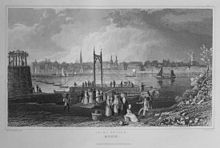
In 1325, Archbishop Heinrich von Virneburg from Cologne transferred the hereditary right to 20 ferrymen to carry people between the mouth of the Sieg and Dollendorf . In 1665, the Archbishop and Elector Maximilian Heinrich of Bavaria asked the ferrymen to build a flying bridge or gierponte . The first Gierponte was not put into operation until the city of Bonn was besieged in 1673. In 1676 it was transferred to the Beuel boatmen. It operated between Josefstrasse in Bonn and the Beuel landing stage in the area of today's war memorial. In 1895 the city council of Bonn decided to build a permanent bridge over the Rhine, which was blown up at the end of World War II and rebuilt in 1948/49.
Friedrich-Breuer-Strasse
The main route of today's Beuel was between the Gierponte and the train station. Today's Friedrich-Breuer-Strasse gained increasing importance through the construction of the Rhine Bridge. Initially, the street from the Rhine to Gottfried-Claren-Straße was called "Koffergasse" (Covergas). "Cover" stands for the medieval name for Kobern (= buy, trade). Later the street became part of the Beueler Overather Chaussee. In 1891 it was in "Hauptstraße" and around 1900 after Kaiser Wilhelm I in "Wilhelmstraße", in 1902 after Kaiser Friedrich III. renamed "Friedrichstrasse". From 1933 to 1945 it was “Horst-Wessel-Straße” , which was renamed “Friedrichstraße” again after the war. With the renaming to "Friedrich-Breuer-Straße" a memorial was erected to the mayor Friedrich Breuer. Friedrich Breuer lived in the old town hall on the 1st floor. As the old town hall soon became too small after the official headquarters were moved from Vilich to Beuel, Friedrich Breuer built himself a new residence in the neo-Gothic style in 1902 . Today it is to the left of the town hall. In 1912, the local council decided to build a new town hall. But this was only realized after 50 years. The handover and inauguration of the new town hall took place on September 27, 1962.
Beuel washerwoman
The bust of an old woman made of sandstone was attached to the bridge pillar of the first Rhine bridge on the Beuel side. It reminded of the Beuel washerwomen . After the demolition, the sculpture was recovered and four years later, for the 125th anniversary of the Beueler Weiberfastnacht , it was rebuilt on the banks of the Rhine next to the pier for the passenger ferry. The 75 cm high sandstone figure was made by the sculptor Brasche based on a design by the Berlin sculptorügelmann.
An inscription in the base commemorates the great times of the bleachers and washerwomen : “De Welt is e Lake, dat selvs de Beueler can't wash”.
Due to the newly built flood protection, the sculpture was dismantled and can now be seen in the Beuel Local History Museum.
Catholic parish church of St. Joseph
This church is a three-aisled basilica in four bays with a transept and polygonal choir . At the front is the 70 meter high tower, in which Saint Joseph is placed in the upper part.
After long disputes with the Prussian government, the first phase of construction (choir, transept and a yoke of the nave) of the church began on August 15, 1880 . It was built on a hill ( Bühel ) that gave Beuel its name. The neo-Gothic church of St. Joseph was until 1893, when Beuel got its own parish, the branch church of the parish of St. Peter in Vilich. The first service took place two years later. On August 18, 1901, the second construction phase with the three remaining yokes of the nave began.
In 1903 the church was completed in its current form. The materials for the construction came from the area. Beuel field fire bricks , facing bricks from Hangelar and basalt bricks from the Oberkassel quarry.
The church is particularly known for its large Oberlinger organ from the 80s, where organ concerts are regularly held. The organ from the organ building workshop Oberlinger, Windesheim, was built in the French-Romantic sound style. The arrangement of the organ (61 registers) was designed by Hans-Peter Reiners in conjunction with master organ builder Ernst Oberlinger.
In addition, the church has one of the largest carillon in Europe with 62 (55) bells, which was installed in 1962. After being unused for a long time over the years, it was expanded in May 2009 to be transported to a Dutch specialist company for restoration. The carillon was renovated for a sum of approx. 100,000 EUR - raised exclusively through donations - and re-inaugurated on September 4, 2010.
The Catholic parish of St. Josef and St. Paulus Beuel maintains its own St. Josef parish cemetery in the triangle of St. Augustiner Straße / Combahnstraße / Kreuzstraße in Beuel Mitte. It is about 5000 square meters and houses about 930 grave sites.
Bröltalbahnhof
The station of the former Bröltalbahn is located in the immediate vicinity of the former Gierponte landing stage . It was the oldest narrow-gauge railway in Germany. The station was the westernmost end point of the route network. From here the transported basalt stone was loaded onto ships. The former station building on Rheinaustraße was built in 1891 as a two-story half-timbered building. In 1906 the building was expanded and a platform roof with a column structure made of cast iron was built. After the railway was closed in 1967, the building was used as a train station restaurant.
The "Bahnhöffje" with its platform terrace is a popular meeting place today.
Combahnstrasse
Combahnstraße takes its name from the then independent town Combahn, which was formed from two settlement centers. It was first mentioned in a document in 1343. On the one hand, the settlement consisted of the area around the later Bröltalbahnhof, which expanded along the Rhine, and on the other hand, the area from Rheinaustraße to today's Friedrich-Breuer-Straße belonged to it. This part of today's Beuels belonged to the Vilicher Ländchen in the Electorate of Cologne. In 1808 Combahn and Beuel were united in one state ( Grand Duchy of Berg ).
Beuel train station
The station complex with a station building in the classicist style was built between 1870 and 1880 between the then still independent villages of Beuel and Combahn. The initially single-track line ran from the Oberkassel Trajekt to Troisdorf and was completed on October 26, 1870 after just a few months of construction. The route was initially only used for military purposes and was opened for other freight traffic in February 1871. The original platform roofs made of ornate wooden posts and the historic goods shed (one of the oldest in Germany) and loading street are now under monument protection. In 1883 the line was expanded to two tracks. Around 1900 the Beuel station also became the starting point for the Beuel – Großenbusch industrial railway . After the construction of the Rhine bridge, a tram connection was established between the Bonn and Beuel stations in 1902.
See also the Bonn – Oberkassel route
Church of Reconciliation
In the period of industrialization, Protestant families settled in Beuel from 1860 onwards. With the help of the Gustav-Adolf-Verein the Protestant community was able to build its own church on Siegfried-Leopold-Straße in Beuel in 1894 according to the plans of the Bonn builder Otto Penner . The brick building was built as a hall church with a one-bay porch. To the side of the polygonal choir is a sacristy extension. In 1959 an aisle was added according to the plans of HA Rolffs. In 1988 a 16-register organ with a carillon consisting of 39 bells was built on the gallery at the back.
Beuel Synagogue
Probably around 1800 a synagogue was built in Beuel in the area of today's Siegfried-Leopold-Straße and Friedrich-Friesen-Straße. In 1903, instead of the old one, a new synagogue was built in the old Wilhelmstrasse 78 according to the plans of the master builder Johann Adam Rüppel. This synagogue is the only one in the Beuel district. It was essentially built as a romanised central building with a high central dome and small facade towers. The building was destroyed on November 10, 1938 during the “ Reichspogromnacht ”. In 1962, the city council of the then city of Beuel installed a commemorative plaque there and in 1988 a memorial sign was erected with the bricks of the former synagogue through the redesign of the former synagogue site.
War memorial
The "Warrior Association" founded in 1869 and the municipality of Combahn erected a war memorial on April 6, 1877 near the Bröltal train station to commemorate those who fell in the Franco-Prussian War of 1870/1871. This monument was designed by the Bonn sculptor Johann Josef Olzem. The eagle sitting on the pillar was melted down during World War II and replaced by a zinc replica.
Bread factory
The Germania bread factory was founded in 1903 at Kreuzstrasse 16 by the factory owner August Osberghaus. The company was sold in the 1930s due to high debts. The new owner Karl Maria Johannes Troullier made sure that the economic development rose steeply. After the war began, orders came from the Wehrmacht . The factory was modernized in the 1970s and produced 1200 breads an hour.
In 1985 the factory was sold. The new owner dismantled the systems for his Cologne operation. Since 1986 the “Germania” has served as an alternative cultural center “bread factory” .
Local museum
The Beuel Local History Museum is the first local history museum in the Bonn area. It was opened on June 7, 1986 on a private initiative on the half-timbered yard in Beuel at Steinerstraße 34-36. The core is a courtyard from the 18th century. In this museum the visitor can find out about the historical development on Beueler Boden. In this way you get to know the Beueler early trades of fishing, shipping and laundry and gain an insight into life, work and living around the turn of the century. During expansion work for the exhibition area, a cellar vault dating from 1600 was exposed.
See also
- List of architectural monuments in the Bonn district of Beuel-Mitte
- List of crossroads and wayside shrines in the Bonn district of Beuel-Mitte
literature
- Monument Authority of the City of Bonn (Ed.): Monument Paths .
- Carl Jakob Bachem : Beuel Chronicle . 1989.
- Bonn as the capital and residence of the Electorate of Cologne. 1597-1794 . In: Dietrich Höroldt (Hrsg.): History of the city of Bonn . tape 3 . Bonn 1989.
Individual evidence
- ↑ Population in Bonn by districts (according to the main statute) on December 31 , 2018 , Federal City of Bonn - Statistics Office, February 2019
- ↑ https://www.baufi24.de/standorte/immobilienmarkt-bonn-baufinanzierung/
- ↑ https://www.general-anzeiger-bonn.de/region/sieg-und-rhein/siegburg/immobilienpreise-in-der-region-erneut-gestiegen_aid-44033339
- ↑ Katrin Ahmerkamp: Without him, Beuel would look different In: General-Anzeiger January 12, 2011
- ↑ Skipper Association wants to raise treasure ; Website of the Schifferverein Beuel ( Memento of the original from September 24, 2015 in the Internet Archive ) Info: The archive link was inserted automatically and has not yet been checked. Please check the original and archive link according to the instructions and then remove this notice.
- ↑ Beuel: One of the largest carillon in Europe sounds again ; General-Anzeiger Bonn from September 1, 2010 ( Memento from September 24, 2015 in the Internet Archive )
- ^ Entry by Svenja Prinz about bread factory in Beuel (former Germania bread factory) in the database " KuLaDig " of the Rhineland Regional Association , accessed on February 16, 2017.
